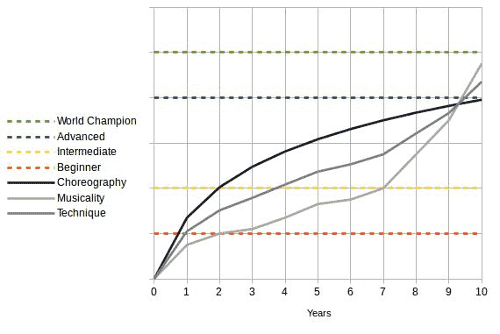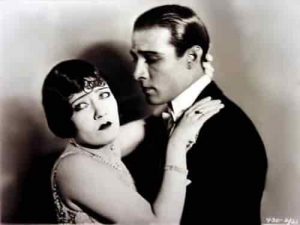 In the world of Argentine tango, there are some milongas whose rules of engagement prohibit any form of asking a person to dance, unless it is done by ‘cabeceo’. The whole idea of cabeceo (‘the pitch’ or leaders invitation) and ‘mirada’ (‘the look’ or followers response) is that a leader can ‘ask’ a follower to dance in a semi-private way.
In the world of Argentine tango, there are some milongas whose rules of engagement prohibit any form of asking a person to dance, unless it is done by ‘cabeceo’. The whole idea of cabeceo (‘the pitch’ or leaders invitation) and ‘mirada’ (‘the look’ or followers response) is that a leader can ‘ask’ a follower to dance in a semi-private way.
This communication happens silently and often over distances as large as the length of a dance hall. If the follower refuses, there is no long walk of shame back across the dance floor for the leader to contend with (we all remember those school discos that scarred us for life, but at the same time toughened us up 🙂 ) , and the follower doesn’t have to accept just because a leader is stood next to them and ‘it would be rude not to’. Lots of embarrassment saved on both sides.
However, there are plenty of opportunities for misfires, as with most communication systems, so let’s first have a refresher of communications theory.
In any communications system there is at least one transmitter, one receiver, and the medium via which a message is transferred. If two way communication is required then there must be a transmitter and receiver at each end of the communication medium so that a message sent one way can be responded to by a message coming back.
So A transmits a message via the medium and B receives the message and sends an acknowledgement that the message has been received. Note, this is not a response to the sense of the message, but simply and acknowledgement of receipt. If B wishes to respond to the message then the communication happens again but initiated by B transmitting a reply to A who responds that they’ve received it.
The system can fail if any combination of transmitter, receiver, and medium fails. All very simple and logical right?
What communications components correspond to the cabeceo scenario?
The communications medium is simply line of sight between leader and follower. The transmitter is initially the leaders cabeceo – his enquiring look at the target follower. The follower is initially a receiver, to first observer the cabeceo, and then having decided to accept the invitation or not, the follower becomes a transmitter, to reply with mirada. The leader then becomes a receiver of the reply, for final interpretation of success or failure of his invitation.
So what could possibly go wrong?
The communications medium needs to be open. If the line of sight is blocked (by other dancers, pillars in the room, or other physical obstacles etc) then communication can’t take place. This is the easiest problem to fix. Both leaders and followers who want to dance just need to make it obvious, perhaps by standing up, moving to an area of the room where they can easily be seen near the edge of the dance floor, and then followers need to be receptive to a leaders Cabeceo.
The leaders transmission needs to be a clear invite. Staring blankly, or with a vaguely ‘mad axe murderer’ expression is probably not going to be successful, either for the leader or as a followers response. If you do see a person seemingly looking your way with a blank stare on their face, it might just mean they’ve zoned out, just listening to the music, and not actually ‘looking’ at anything in particular. So leaders need to smile, or nod to make sure the follower knows is definitely them the leader is wanting to communicate with. So the leader is now transmitting and the comms medium is clear.
The follower needs to make eye contact long enough for the leader to know the ‘comms line is now open’, even if the followers response is going to be a ‘no thank you’. This eye contact is the acknowledgement that the message has been received, but is not the reply to the message. Without it, the communication loop has not been established. I have observed some followers who just continually scan the room without making eye contact (or at least not making eye contact for long enough to be certain of the fact). In this case the communication loop is not complete. This type of ‘follower scanning’ seems to be saying to the audience of leaders at large ‘I am looking for one of a specific group of friends to dance with, not a stranger’.
So once the follower has caught the eye of the leader and his invitation, they can now either smile, nod etc. to accept the invitation, or do a little shake of the head, or just look away to decline the invitation. However there must be eye contact for that brief exchange, for this to be clearly interpreted by the leader.
So as long as we stick to the above basic rules of communication cabeceo works right? Well not always.
There are other cabeceo problems.
Now we need to examine a little radar theory (bear with me 🙂 ). So with radar the idea is to identify moving objects from static objects, so that on a military field of battle for example, you can tell which blip on the screen is a moving enemy tank and which is just a static building. To do this a radar installation will send regular electronic pulses from two separate points and measure the reflected signal. Sending pulses from two different points allows us to establish range and location. If the position of a blip has moved since the last pulse was sent out, that is probably the tank.
However, what if two objects are so close that it is difficult to separate their blips on the screen? If the tank stops moving, close to the building, the blips merge and the reflected pulse can’t discriminate accurately between the two objects.
With cabeceo, this is the case when a follower thinks a leader is inviting them when in fact the target is next door, or behind. So what to do here? Well, followers can perhaps ease the situation by not bunching up, although in a crowded milonga and with typical seating arrangements this can be pretty much impossible.
The leader now has to respond to one of the followers. If there is only one response, but not the original target, the polite thing to do is to dance with the only follower who is offering to dance with you. Not all leaders are that polite… but if the leader is there to dance, why pass up an offer?
If there are two or more followers responding, then the polite thing to do would be to pick one follower but promise the other(s) the next tanda(s). Remember that this miscommunication is no ones fault, so followers shouldn’t take it personally if the leader doesn’t pick them first (as long as the leader comes back and fulfils their promise for the next tanda). Again, not all leaders will… but if leaders are there to dance then they’re sorted for the next couple of tandas, so why not?
The use of cabeceo and mirada can also be ‘abused’.
It’s true that if you’ve paid your money to enter a milonga for a night out, you want a good time and you are within your rights to pick and choose who you dance with (or even who you consider worthy enough to dance with).
It’s worth remembering though that you were once a beginner and maybe not so hot at dancing. You needed better dancers than you to invite you, or accept your invitation to dance to help you become a better dancer. If tango clubs can’t attract new people because they are too ‘cliquey’, too unfriendly, have too many ‘weird’ rules, etc. then the club may eventually wither away.
So while it’s possible to use cabeceo and mirada to exclude strangers, dancers deemed ‘not good enough’, or a myriad of other elitist reasons for exclusion, in the end it won’t be helping your tango community to grow, possibly quite the opposite.
Personally I am neither strongly for, or strongly against the cabeceo tradition. It has it’s advantages, and it’s flaws (in my case, the typical range falls outside my long vision, but not into the range where my reading glasses would help 🙂 ).
However there’s no harm in giving it a go. If you’ve never tried it, stick to the basics as described above, but don’t get too despondent if it doesn’t work every time. I would also suggest to all tango dancers of all abilities, if someone verbally asks you to dance, you still have the choice of accepting or politely refusing. Is it such a big deal that someone didn’t cabeceo you, or wait to be cabeceo’d by you, instead of asking? Surely the dancing and socialising are more important than holding tight to a set of social rules imported from another country (assuming you’re not reading this in Argentina, in which case cabeceo away 🙂 ).
Let’s not get too uptight about these rules, but rather help those who want to learn about them to learn, and find ways of accommodating those who don’t 🙂
What are your thoughts?









